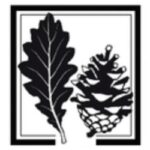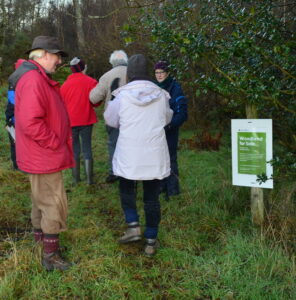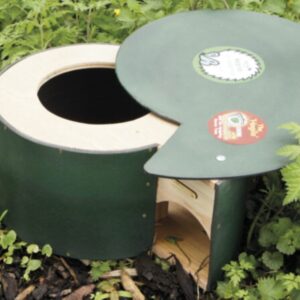Upgraded noticeboard at west entrance to Taymount Wood
What has WSWG been doing this month?
For WSWG, our vision for Taymount Wood and Five Mile Wood has always been as part of the wider activity for nature, climate and community in the West Stormont area. In that regard, WSWG has recently been developing our corresponding Outreach and Connectivity theme “Beyond the Woods” through various projects and activities with the community in Stanley.
We are part of the Rookery Wood Working Group which has been developing an outline plan for bringing this small PKC-owned woodland in Stanley into the custodianship of the local community. We will hear soon from PKC as to whether our outline proposal is acceptable before developing it further with the wider community in Stanley.
WSWG is also supporting a project of the Stanley Development Trust which they have submitted for the PKC Green Living Fund. The Common Ground Garden Project will turn a neglected space into a thriving community garden where families can grow food, share skills, and build resilience. Using recycled materials, it will become a green hub that tackles the cost of living, boosts wellbeing, and takes real climate action in the village. The garden will also include a small community tree nursery to grow tree saplings for planting out in local woodlands. Here’s hoping the recent community voting phase will result in an early start for this exciting project.
On 20 October and 17 November, we updated the Stanley and District Community Council meeting on the WSWG Project, the Rookery Wood Project and the range of things which are happening as part of the Stanley Biodiversity Village Project. Taymount Wood and Five Mile Wood are both within the Stanley Biodiversity Village area.
On 31 October, we had a wonderful walk in Taymount Wood with the Stanley Health Walk Group which also provided footage for our Outreach and Connectivity-themed video commissioned by Climate Connect Perth and Kinross, including great interviews with some of the 23 walkers who came along. The windblown trees blocking the main track in from the car park had not been cleared and so, unusually, the event started at the western entrance to the wood. A local resident very kindly allowed us to park nearby and WSWG set up a gazebo in the garden at King’s Myre Cottage (big thank you to John and Lynn) with a display of biodiversity activity carried out by WSWG and the Stanley Biodiversity Village Project. 2025 is a mast year for oak and event participants were invited to sow some acorns gathered from mature oak trees along the southern edge of Taymount Wood by the car park. Hopefully these acorns will produce seedlings in the spring which can be grown on and planted out as saplings in Taymount and Five Mile Wood in due course. Thank you to all the lovely Stanley walkers for visiting the wood and we look forward to more walks with them in future. We will hopefully be seeing the draft video quite soon, so it should be available for wider viewing before long.
Having seen a wee red squirrel risking its life fetching acorns from the huge glut heaped along the edge of the carriageway, when we collected the ones for planting, we took the opportunity to rake the rest back into the woodland edge at the same time. Thankfully, no squirrel road casualties have been reported at this spot. However, a WSWG member reported that sadly a pine marten was recently seen dead on the U38 road near the south end of Five Mile Wood. Just so sad how vulnerable our wildlife is on our roads.
We are pleased to say that the windblown trees blocking the main track in Taymount Wood were cleared at the beginning of November, restoring normal access to the wood from the car park, so thank you to FLS for that.


On 12 November, the Rewilding Denmarkfield Project, together with WSWG, delivered a joint presentation on our respective projects to the Nature Section of the Perthshire Society of Natural Science as part of their winter talks programme at the AK Bell Library. The idea was to showcase local community projects which are working on nature conservation. It was a very enjoyable evening and the idea has already been set in motion to arrange follow-up field visits for PSNS members in 2026, so we’re looking forward to that very much.
A big part of the WSWG board’s current focus is our ongoing research around the next steps for the WSWG Project, which has included meetings and discussion with Forestry and Land Scotland, the Kilsture Forest Community Group from Dumfries and Galloway, and Perthshire forester, Dirk Sporleder who is part of the Forest Policy Group and has a particular interest in Continuous Cover Forestry. Some interesting change is in the air, so we’ll be providing updates on this as we go.
Word of the Month
Mast year: Every species of tree and shrub has a distinctive way of reproducing. Autumn is the prime time to see this and can help us recognise different species too. Acorns, conkers, winged seeds and an array of fruits, berries and cones make autumn’s colourful leaf displays even more enjoyable.
Every few years, some species of trees and shrubs produce a bumper crop of their fruits or nuts. The collective term for these fruits and nuts is ‘mast’, so we call this a mast year.
Two of our most recognisable trees, oak and beech, fluctuate massively year on year in the amount of acorns and beech nuts they produce. Some years seem to have very little while in others, the fallen nuts create a thick carpet beneath the trees. One of the main theories for this behaviour is ‘predator satiation’. Take oak and beech as an example again. Animals like squirrels, jays, mice and badgers feed on the acorns and beech nuts. When the trees produce smaller crops for a few consecutive years, they’re effectively keeping the populations of these animals in check. But during a mast year, the trees produce more food than the animals can possibly eat.
This abundance causes a boom in populations of small mammals like mice. More importantly, it guarantees some will be left over to survive and grow into new trees. Mast years have a major evolutionary advantage for the tree. Producing nuts is costly work and slightly stunts the tree’s growth, but as it tends to happen every 5-10 years, it’s worth the payoff for some of the crop to germinate into new saplings. Source: www.woodlandtrust.org.uk
Book of the Month
“How to Read a Tree” by Tristan Gooley: Trees are keen to tell us so much. They’ll tell us about the land, the water, the people, the animals, the weather, and time. And they will tell us about their lives, the good bits and bad. Trees tell a story, but only to those who know how to read it.
In How to Read a Tree, Gooley uncovers the clues hiding in plain sight: in a tree’s branches and leaves; its bark, buds, and flowers; even its stump. Leaves with a pale, central streak mean that water is nearby. Young, low-growing branches show that a tree is struggling. And reddish or purple bark signals new growth.
Like snowflakes, no two trees are exactly the same. Every difference reveals the epic story this tree has lived—if we stop to look closely.
Publisher: Hodder & Stoughton ISBN: 9781529339628
Source: www.goodreads.com

What’s coming up next?
National Tree Week 2025 takes place between 22 – 30 November. Co-ordinated by the Tree Council and partners, this year is the 50th anniversary of this national celebration of all things tree and, as the Tree Council says, “it is the perfect chance for everyone to reconnect with trees and nature as the planting season begins. National Tree Week marks the official start of the tree planting season, so don your wellies, grab a spade and get involved! Take part in a local tree planting event to enrich your community and boost wildlife; pop down to your local library to celebrate the trees that make your area special; or tune in to one of our free, inspiring online talks.”
Apart from participating in the Stanley Christmas Tree Festival (see below), WSWG has no specific event planned for Tree Week but some time in December (weather permitting!) we will be planting about 25 fruit trees in Taymount Wood. We’ll be looking for a few volunteers to help us, so if you would like to be involved, please get in touch so we can include you in planning the best date or dates. To get in touch, email us at: contact@weststormontwoodlandgroup.scot
Saturday 29 November, 10am to 2pm: WSWG is taking part in the Stanley Christmas Tree Festival at Stanley Primary School by displaying a tree decorated in a theme and style of our choice. This will be a lovely seasonal event and raises valuable funds for the school, so please do come along and enjoy it with us if you can.








